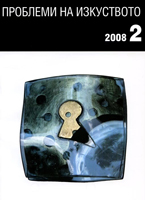„Въртящитe се дискове“ от Боянската църква
„The Spinning Discs” from the Boyana Church
Author(s): Svetozara RacevaSubject(s): Cultural history
Published by: Институт за изследване на изкуствата, Българска академия на науките
Summary/Abstract: This study focuses on the two “spinning” discs flanking the encircled radiant God’s hand and above the Holy Virgin with the infant in the narthex drum of the Church of st. Nicholas and st. Panteleimon in Boyana. These abstract symbols of God’s light and energy are commonly present in the programs of Serbian, Cyprus and Georgian churches but have no analogue in Bulgaria, apart from the Boyana church. All presently known mural interpretations of spinning discs imitate the circularly polished nimbi of the sinai icons through graphically presented concentric circles. in a publication, e. Schwarz convincingly studies these elements as a result of the transfer and transformation of symbols between easel and monumental artistic forms. Basing our argument on the above observations, we have set ourselves the following tasks: to clarify the problems concerning the origin, function and specific semantics of the two spinning discs within the context of the overall drum program; to position them on the complex historical and cultural background of church art in the Balkans during the thirteenth century and to mark them out as an artifact that demonstrates the contacts between Bulgaria and sinai during this period. Following the well-recognized point of view expressed in the critical literature concerning the icon prototype of the Holy Virgin with the infant from the Boyana drum, we suggest a somewhat different hypothesis that not only the image of the Holy Virgin but the whole drum refigures an icon program. We allude to icons in which the protective “casket” is developed into a wide gilded frame around the central image. Most known monuments of this type are dated between the end of the tenth century and the thirteenth century and come from the sinai monastery of st. Catherine. Usually the upper part of these specific “frames” present versions of Deesis, etoimasia or Christ in Glory, flanked by seraphim. The side-fields are preserved for holy personages. Studying all possible interpretations, we have determined the configuration which is closest to the symbols presented in the upper part of the Boyana drum. The replacement of the image of the Heavenly King with His Hand blessing the four cardinal points (the rays); His incarnation, accented by the presence of st. Joachim and st. Anna; the use of the same approach towards the representatives of His Hosts, replaced by abstract symbols (the spinning discs) – all testify to the exceptional theological erudition of the artist or the commissioner of the frescoes. Since in this case we assume that this is a mural replica of an icon with a possible sinai origin, in the thirteenth century such a model could have been observed by either of them not only in the monastery of st. Catherine but in other cultural centers as well. Such a possibility, together with the typical sinai “translation” of the symbols of the light- not-made-by-hand, add the 1259 frescoes from the narthex of the Boyana Church of st. Nicholas.
Journal: Проблеми на изкуството
- Issue Year: 2008
- Issue No: 2
- Page Range: 16-22
- Page Count: 7
- Content File-PDF

